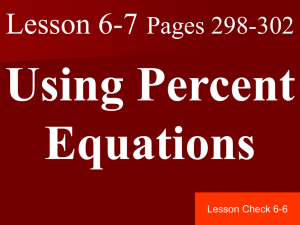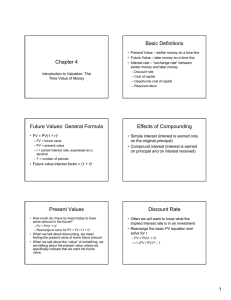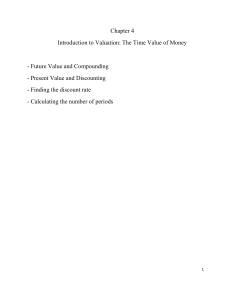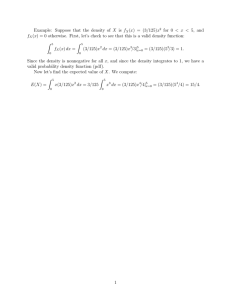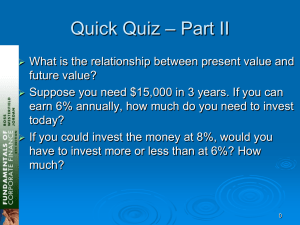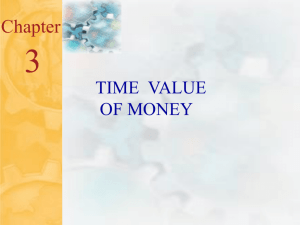Key Concepts and Skills Chapter Outline Basic Definitions Future
advertisement
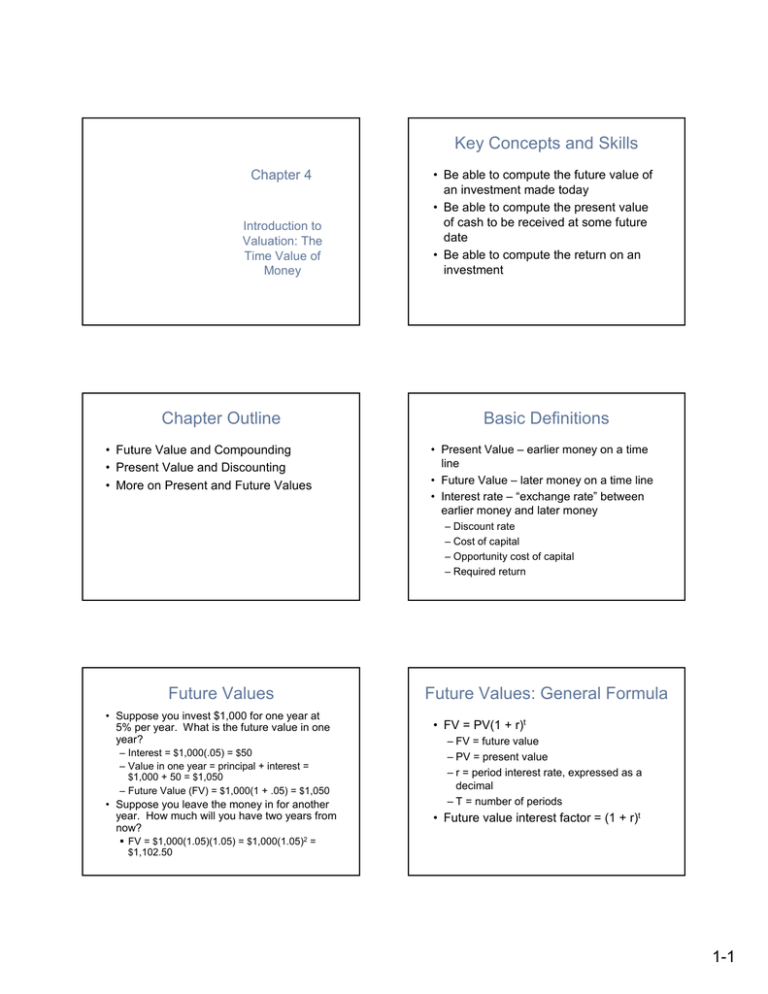
Key Concepts and Skills Chapter 4 Introduction to Valuation: The Time Value of Money Chapter Outline • Future Value and Compounding • Present Value and Discounting • More on Present and Future Values • Be able to compute the future value of an investment made today • Be able to compute the present value of cash to be received at some future date • Be able to compute the return on an investment Basic Definitions • Present Value – earlier money on a time line • Future Value – later money on a time line • Interest rate – “exchange rate” between earlier money and later money – Discount rate – Cost of capital – Opportunity cost of capital – Required return Future Values • Suppose you invest $1,000 for one year at 5% per year. What is the future value in one year? – Interest = $1,000(.05) = $50 – Value in one year = principal + interest = $1,000 + 50 = $1,050 – Future Value (FV) = $1,000(1 + .05) = $1,050 • Suppose you leave the money in for another year. How much will you have two years from now? Future Values: General Formula • FV = PV(1 + r)t – FV = future value – PV = present value – r = period interest rate, expressed as a decimal – T = number of periods • Future value interest factor = (1 + r)t FV = $1,000(1.05)(1.05) = $1,000(1.05)2 = $1,102.50 1-1 Effects of Compounding Figure 4.1 • Simple interest (interest is earned only on the original principal) • Compound interest (interest is earned on principal and on interest received) • Consider the previous example – FV with simple interest = $1,000 + 50 + 50 = $1,100 – FV with compound interest = $1,102.50 – The extra $2.50 comes from the interest of .05($50) = $2.50 earned on the first interest payment Figure 4.2 Calculator Keys • Texas Instruments BA-II Plus – FV = future value – PV = present value – I/Y = period interest rate • P/Y must equal 1 for the I/Y to be the period rate • Interest is entered as a percent, not a decimal – N = number of periods – Remember to clear the registers (CLR TVM) before (and after) each problem – Other calculators are similar in format Future Values – Example 2 • Suppose you invest the $1,000 from the previous example for 5 years. How much would you have? FV = $1,000(1.05)5 = $1,276.28 • The effect of compounding is small for a small number of periods, but increases as the number of periods increases. (Simple interest would have a future value of $1,250, for a difference of $26.28.) Future Values – Example 3 • Suppose you had a relative deposit $10 at 5.5% interest 200 years ago. How much would the investment be worth today? – FV = $10(1.055)200 = $447,189.84 • What is the effect of compounding? – Simple interest = $10 + $10(200)(.055) = $120 – Compounding added $447,069.84 to the value of the investment 1-2 Future Value as a General Growth Formula • Suppose your company expects to increase unit sales of widgets by 15% per year for the next 5 years. If you currently sell 3 million widgets in one year, how many widgets do you expect to sell during the fifth year? FV = 3,000,000(1.15)5 = 6,034,072 Quick Quiz: Part 1 • What is the difference between simple interest and compound interest? • Suppose you have $500 to invest and you believe that you can earn 8% per year over the next 15 years. – How much would you have at the end of 15 years using compound interest? – How much would you have using simple interest? Present Values PV – One-Period Example • How much do I have to invest today to have some amount in the future? • Suppose you need $10,000 in one year for the down payment on a new car. If you can earn 7% annually, how much do you need to invest today? • PV = $10,000 / (1.07)1 = $9,345.79 • Calculator FV = PV(1 + r)t Rearrange to solve for PV = FV / (1 + r)t • When we talk about discounting, we mean finding the present value of some future amount. • When we talk about the “value” of something, we are talking about the present value unless we specifically indicate that we want the future value. Present Values – Example 2 • You want to begin saving for your daughter’s college education and you estimate that she will need $150,000 in 17 years. If you feel confident that you can earn 8% per year, how much do you need to invest today? PV = $150,000 / (1.08)17 = $40,540.34 1N 7 I/Y 10,000 FV CPT PV = -9,345.79 Present Values – Example 3 Your parents set up a trust fund for you 10 years ago that is now worth $19,671.51. If the fund earned 7% per year, how much did your parents invest? PV = $19,671.51 / (1.07)10 = $10,000 1-3 PV – Important Relationship I PV – Important Relationship II • For a given interest rate – the longer the time period, the lower the present value (ceteris paribus: all else equal) • For a given time period – the higher the interest rate, the smaller the present value (ceteris paribus) – What is the present value of $500 to be received in 5 years? 10 years? The discount rate is 10% – 5 years: PV = $500 / (1.1)5 = $310.46 – 10 years: PV = $500 / (1.1)10 = $192.77 – What is the present value of $500 received in 5 years if the interest rate is 10%? 15%? Figure 4.3 Quick Quiz: Part 2 • Rate = 10%: PV = $500 / (1.1)5 = $310.46 • Rate = 15%; PV = $500 / (1.15)5 = $248.59 • What is the relationship between present value and future value? • Suppose you need $15,000 in 3 years. If you can earn 6% annually, how much do you need to invest today? • If you could invest the money at 8%, would you have to invest more or less than at 6%? How much? The Basic PV Equation Refresher • PV = FV / (1 + r)t • There are four parts to this equation – PV, FV, r, and t – If we know any three, we can solve for the fourth • If you are using a financial calculator, be sure to remember the sign convention or you will receive an error when solving for r or t Discount Rate • Often, we will want to know what the implied interest rate is in an investment • Rearrange the basic PV equation and solve for r FV = PV(1 + r)t r = (FV / PV)1/t – 1 • If you are using formulas, you will want to make use of both the yx and the 1/x keys 1-4 Discount Rate – Example 1 Discount Rate – Example 2 • You are looking at an investment that will pay $1,200 in 5 years if you invest $1,000 today. What is the implied rate of interest? • Suppose you are offered an investment that will allow you to double your money in 6 years. You have $10,000 to invest. What is the implied rate of interest? r = ($1,200 / $1,000)1/5 – 1 = .03714 = 3.714% Calculator – the sign convention matters!!! • N=5 • PV = -1,000 (you pay $1,000 today) • FV = 1,200 (you receive $1,200 in 5 years) • CPT I/Y = 3.714% Discount Rate – Example 3 • Suppose you have a 1-year old son and you want to provide $75,000 in 17 years toward his college education. You currently have $5,000 to invest. What interest rate must you earn to have the $75,000 when you need it? r = ($75,000 / $5,000)1/17 – 1 = .172686 = 17.27% r = ($20,000 / $10,000)1/6 – 1 = .122462 = 12.25% Quick Quiz: Part 3 • What are some situations in which you might want to compute the implied interest rate? • Suppose you are offered the following investment choices: – You can invest $500 today and receive $600 in 5 years. The investment is considered low risk. – You can invest the $500 in a bank account paying 4% annually. – What is the implied interest rate for the first choice and which investment should you choose? Finding the Number of Periods Number of Periods – Example 1 • Start with basic equation and solve for t (remember your logs) • You want to purchase a new car and you are willing to pay $20,000. If you can invest at 10% per year and you currently have $15,000, how long will it be before you have enough money to pay cash for the car? FV = PV(1 + r)t t = ln(FV / PV) / ln(1 + r) • You can use the financial keys on the calculator as well. Just remember the sign convention. t = ln($20,000 / $15,000) / ln(1.1) = 3.02 years 1-5 Number of Periods – Example 2 • Suppose you want to buy a new house. You currently have $15,000 and you figure you need to have a 10% down payment plus an additional 5% in closing costs. If the type of house you want costs about $150,000 and you can earn 7.5% per year, how long will it be before you have enough money for the down payment and closing costs? Table 4.4 Example 2 Continued • How much do you need to have in the future? – Down payment = .1($150,000) = $15,000 – Closing costs = .05($150,000 – 15,000) = $6,750 – Total needed = $15,000 + 6,750 = $21,750 • Compute the number of periods – – – – PV = -15,000 FV = 21,750 I/Y = 7.5 CPT N = 5.14 years • Using the formula – t = ln($21,750 / $15,000) / ln(1.075) = 5.14 years Quick Quiz: Part 4 • When might you want to compute the number of periods? • Suppose you want to buy some new furniture for your family room. You currently have $500 and the furniture you want costs $600. If you can earn 6%, how long will you have to wait if you don’t add any additional money? Comprehensive Problem • You have $10,000 to invest for five years. • How much additional interest will you earn if the investment provides a 5% annual return, when compared to a 4.5% annual return? • How long will it take your $10,000 to double in value if it earns 5% annually? • What annual rate has been earned if $1,000 grows into $4,000 in 20 years? 1-6

